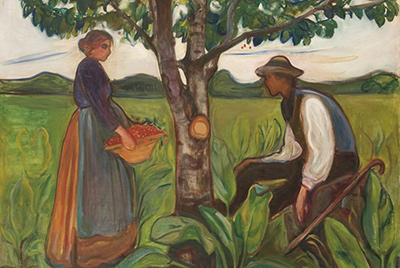Munch painted Fertility in 1899, at a time when his lover Tulla Larsen was pressing him to marry her, and encapsulates his mixed feelings - he eventually fled from Kristiania (Oslo) to Berlin a year later.
At first sight it's a simple painting, almost like a piece of folk art. There's a man, a woman, and a tree, like a naive treatment of the Bible story of Adam and Eve. Munch converts the scene into a series of static patterns - the fleshy big leaves in the foreground, the wavy line of the mountains (into which the man's hat fits almost as if it's another mountain peak), and the green and orange slashes of the greenery in the field in the background.
The two figures are nicely balanced; both wear patches of the same blue, her dress and his waistcoat; but she stands, and he sits, and while she holds a basket of fruit (a symbol of fertility and perhaps an allusion to Eve's apple, though the fruit here looks more like cherries), he has a walking stick. Everything is not as simple as it seems. The story isn't a happy one. The clue of the walking stick shows that the man is in some way disabled and even sterile. He sits slumped - Munch lovingly paints the material of his shirt sleeves sagging, and his hands hang downwards.
He is passive, his face in shadow. He refuses to look at the figure of female fertility. There is no serpent in the tree, but the tree trunk is interrupted by a very prominent stump of a sawn-off branch. Perhaps this symbolises a feeling of impotence or of incompleteness; it also, strangely, looks a little like Eve's apple, but this time interpreted as a sign of fallen humanity and of death, rather than the fertility that the female figure promises with her basket.
With this painting Munch addresses his mixed feelings about the commitment to marriage and, possibly, children that Tulla was asking him for. It also continues a fascination with the figure of the femme fatale in his work; the woman's dark eye suggests she is not entirely innocent. In the end, Munch never did marry, and at his death left all the paintings in his possession to the City of Oslo, where they are now displayed in the Munch Museum.




